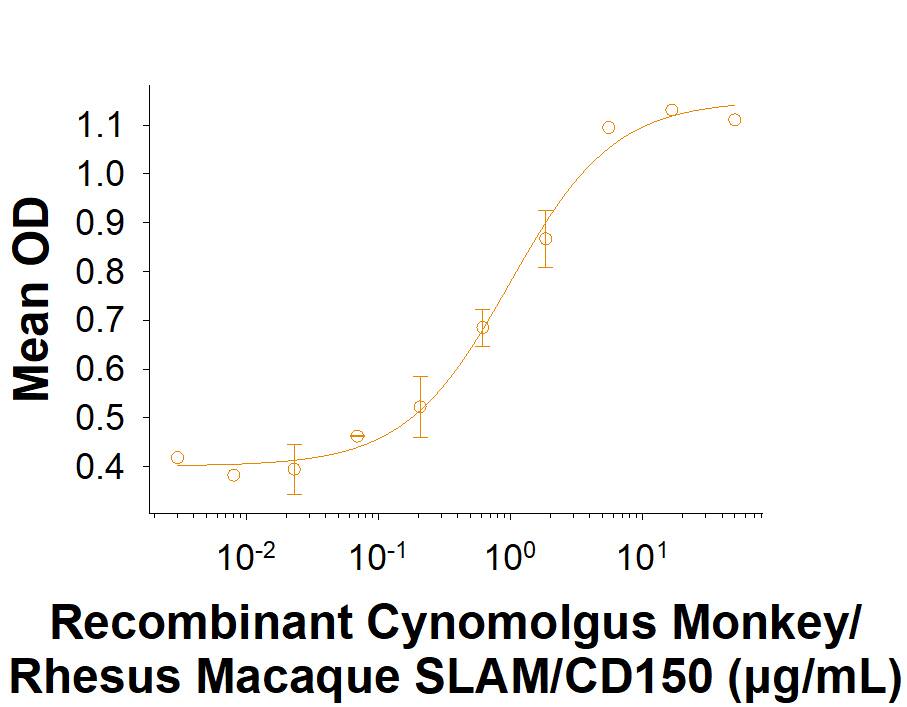Recombinant Cynomolgus/Rhesus SLAM/CD150 His-tag Protein, CF
R&D Systems, part of Bio-Techne | Catalog # 10971-SL

Key Product Details
Product Specifications
Source
Chinese Hamster Ovary cell line, CHO-derived SLAM/CD150 protein
Tyr23-Lys236, with a C-terminal 6-His tag
Tyr23-Lys236, with a C-terminal 6-His tag
Purity
>95%, by SDS-PAGE visualized with Silver Staining and quantitative densitometry by Coomassie® Blue Staining.
Endotoxin Level
<0.10 EU per 1 μg of the protein by the LAL method.
N-terminal Sequence Analysis
Tyr23 & Thr25
Predicted Molecular Mass
25 kDa
SDS-PAGE
42-55 kDa, under reducing conditions.
Activity
Measured by its ability to co-stimulate IL-4 secretion by D10.G4.1 mouse helper T cells in the presence of anti-CD3. The ED50 for this effect is 0.500-2.50 μg/mL.
Scientific Data Images for Recombinant Cynomolgus/Rhesus SLAM/CD150 His-tag Protein, CF
Recombinant Cynomolgus Monkey/Rhesus Macaque SLAM/CD150 His-tag Protein Bioactivity.
Measured by its ability to co-stimulate IL-4 secretion by D10.G4.1 mouse helper T cells in the presence of anti-CD3. The ED50 for this effect is 0.500-2.50 μg/mL.Recombinant Cynomolgus Monkey/Rhesus Macaque SLAM/CD150 His-tag Protein SDS-PAGE.
2 μg/lane of Recombinant Cynomolgus Monkey/Rhesus Macaque SLAM/CD150 His-tag Protein (Catalog # 10971-SL) was resolved with SDS-PAGE under reducing (R) and non-reducing (NR) conditions and visualized by Coomassie® Blue staining, showing bands at 42-55 kDa.Formulation, Preparation and Storage
10971-SL
| Formulation | Lyophilized from a 0.2 μm filtered solution in PBS with Trehalose. |
| Reconstitution | Reconstitute at 250 μg/mL in PBS. |
| Shipping | The product is shipped at ambient temperature. Upon receipt, store it immediately at the temperature recommended below. |
| Stability & Storage | Use a manual defrost freezer and avoid repeated freeze-thaw cycles.
|
Background: SLAM/CD150
References
- Yurchenko, M. et al. (2018) J. Cell. Biol. 217:1411.
- Pellegrini, J. et al. (2021) Autophagy. 17:2629.
- Wang, N. et al. (2015) Front. Immunol. 6:158.
- Gordiienko, I. (2019) Clinical Immunol. 204:14.
- Calpe, S. et al. (2008) Adv Immunol. 97:177.
- Wang, N. et al. (2004) J. Exp. Med. 199:1255.
- Mavaddat, N. et al. (2000) J. Biol. Chem. 275:28100.
- Mehrle, S. et al. (2008) Mol. Immunol. 45:796.
- Yurchenko, M.Y. et al. (2005) Exp Oncol. 27:24.
- Hsu, E.C. et al. (2001) Virology 279:9.
- Gonçalves-Carneiro, D. et al. (2017) J Virol. 91:e02255.
- Gian, M.R. et al. (2021) Br. J. Haematol. 192:1068.
Long Name
Signaling Lymphocytic Activation Molecule
Alternate Names
CD150, IPO-3, SLAMF1
Gene Symbol
SLAMF1
UniProt
Additional SLAM/CD150 Products
Product Documents for Recombinant Cynomolgus/Rhesus SLAM/CD150 His-tag Protein, CF
Product Specific Notices for Recombinant Cynomolgus/Rhesus SLAM/CD150 His-tag Protein, CF
For research use only
